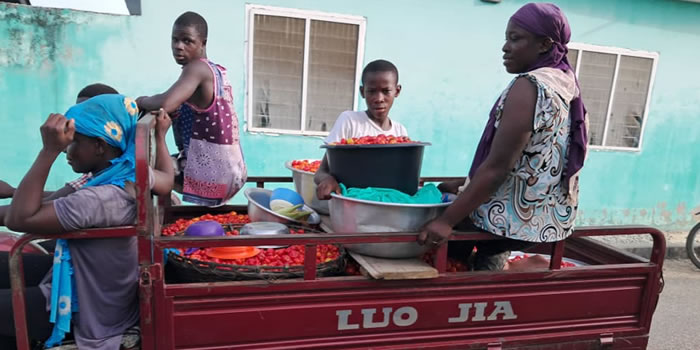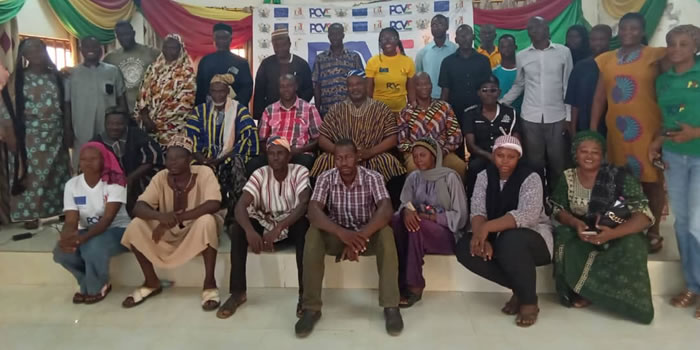

Introduction
In the 2010 Population and Housing Census, a household was defined as “a person or a group of persons, who live together in the same house or compound, share the same house-keeping arrangements and recognise one person as the head of household” (Ghana Statistical Service, 2010). Households constitute major components in planning for goods and services.
In Ghana for instance, some social intervention programmes are targeted at the household. Some of these interventions include cash transfer to the extremely poor and the vulnerable, such as the Livelihood Empowerment Against Poverty Programme (LEAP) and the National Health Insurance Scheme (NHIS) in which household data provide inputs for calculating premiums and targeting those who should be exempted from the payment of premium.
Households are also central to the study of income, maintenance, economic dependency, savings, fertility, migration and social welfare (Tacoli, 2012). Households are often portrayed as relatively static units, with extended forms prevalent in rural areas and nuclear forms in urban areas. The reality is that the composition of households is frequently much more fluid, and their organisation changes as it is affected by the life cycle of their members (births, deaths, marriages), access to resources such as housing and income, and access to adequate education and healthcare (Buzaret al, 2005).
This chapter analyses household size, composition, structure and headships using data from the 2010 Population and Housing Census in the Kumbungu District. Issues on religious affiliation, literacy and education would as well be discussed. 3.2 Household Size, Composition and Structure 3.2.1 Household size The Kumbungu district has a household population of 39,033 representing 99.2 percent of the total population of the district. Average household size in the district is 9.5 (approximately nine people in a house) which is higher than the Northern region average of 7.8.
Household composition refers to the patterns of relationships between the head of household and other members of the household. This includes relationships such as spouse (wife/husband), child (son/daughter), grandchild, parent/parent-in-law, brother/sister, other relative and non-relative. (Ghana Statistical Service, 2010). Table 3.2 depicts the composition of household by sex. From the Table, the total household population is 39,033. Heads of households represent 10.6 percent of the household population.
Children (sons/daughters) constitute a high percentage (48.4%) of population in households; other relatives represent 11.4 percent and non-relatives 0.4 percent. Household composition by sex shows that, male children constitute 56.3 percent of male household population.
Male heads form 19.9 percent and 0.3 percent males are spouses. As expected, female biological children constitute the largest proportion (40.5%) of female household population. Female spouses represent 17.9 percent of female household population. Other relatives also constitute a significant portion of the household population and this can be attributed to the fact that the district is rural and the extended family system is largely practiced (Buzar et al, 2005).
Household structure
Household structure is defined as classification of ties of affiliation of persons who constitute households. In other words, it refers to the type of relationship (whether related or unrelated) between household members who were present on census night. Classification of households depend on whether it is a single person household, household that consists of head and spouse only, nuclear household (head, spouse(s) and their children) or extended among other combinations.
Table 3.3 shows that the extended family system (Head, spouse(s), children and Head’s relatives) dominates with 71.8 percent of the household population, This is followed by the nuclear (i.e. Head, spouse(s) and children) with 14.6 percent of the household population living in the nuclear family. The least is the Head only that is single person 26 household, with only 56 people (0.1%). This can also be interpreted to mean that there are 56 single person households in the district.
Marital Status
Figure 3.1 shows marital status of persons 12 years and older. About 62.0 percent of the population 12 years and older in the district are married and 32.5 percent have never married. People who have ever married but are no more in marriage due to divorce, separation or widowhood constitute 5.4 percent of the population 12 years and older. The least percentage (0.3%) occurred for the people in Informal, Consensual union/Living together.
The distribution of population 12 years and older by sex, age group and marital status is represented in Table 3.4. Over 70.0 percent of males who have never married are in the age groups of 12-14, 15-19 and 20-24. In the female category, 70.7 percent of females in the age group 20-24 are married. Only 28.1 percent of males in the same age group are married.
The Table also shows that for all age groups from 12 to 39, the proportion of females who are married is higher than the corresponding male age groups. The never married recorded 42.4 percent for males and 22.8 percent for females. It can be observed that there is a direct relationship between marital status and age.
Thus, as age increases, so does the married population. 3.3.2 Marital status and level of education Education delays the time at which a person gets married (Oppenheimer, 1988). Table 3.5 shows the distribution of persons 12 years and older by sex and level of education.
Out of the total of 23,874 persons 12 years and older, 74.6 percent had no form of education whilst 0.8 percent have Post-secondary certificate or diploma. Also, 86.0 percent of the married population have no education with 11.1 percent having basic education. Married persons with education beyond the basic level constitute less than three percent of the married population. A high percentage of male and female in all marital categories have no education.
Marital status and economic activity
Table 3.6 shows the marital status of persons 12 years and older by sex and their activity status. Amongst a total of 14,762 married persons 12 years and older, 85.4 percent of are employed with 1.3 percent being unemployed and 13.3 percent being economically not active. Over 70.0 percent of persons who are in the following categories of marital status: Informal/Consensual union/Living together (82.4%), Separated (79.7%), and Divorced (73.2%) are employed.
A small percentage of persons who are divorced (2.2%) and widowed (0.9%) are unemployed and 24.6 percent and 51.3 percent respectively are not economically active. In the male category, 89.7 percent of married males are employed, 0.9 percent are unemployed and 9.4 percent are not economically active. About four out of every five females who are married (82.1%) are employed, 1.6 percent are unemployed and 16.3 percent are not economically active.
Nationality is defined as the country to which a person belongs. Ghanaian nationals are classified as Ghanaian by birth, Dual nationality (Ghanaian & Other) and Ghanaian by naturalization. Table 3.7 illustrates the nationality of the population in the district by sex. Out of the population of 39,341 in the district, Ghanaian nationals by birth represent 95.8 percent, Ghanaians with dual nationality is 1.8 percent and Ghanaians by naturalization is 0.6 percent. 30 Residents from ECOWAS countries made up 0.8 percent of the total population whiles residents from other parts of the world constitute about one percent.
Religious Affiliation
Table 3.8 shows the population of the district by religion and sex. The Table indicates that Islam is the predominant religion in the district. About 96.0 percent of the population reported to be Muslims. Christians (Catholic, Protestant, Pentecostal/Charismatic and other Christian) constitute 2.8 percent and Traditionalists,1.2 percent. Less than one percent indicated that they have no religion.
Housing
Introduction
The 2010 Ghana Population and Housing Census like 2000 census included a comprehensive housing census. The census provided an official count of all structures (permanent and temporary) within the nation. Among the indicators covered were the number of occupied and unoccupied dwelling units, the type of dwelling and the main materials used in house construction, occupancy status, and methods of waste disposal, utilities and household facilities.
It is envisaged that the housing data from the Census will provide planners and policy makers with the relevant data to formulate realistic and relevant housing policies and design appropriate programmes to meet Ghana’s housing needs. In this chapter, data on stock of houses, facilities and amenities of houses in the 2010 Population and Housing Census have been analysed for the Kumbungu District.
Housing Stock
Table 8.1 shows the stock of houses and households by type of locality. The table shows that there are 3,538 houses in the district with the average households per house being 1.2. The population per house is 11.1 whilst the average household size for the district is 9.5. The average household size for the district (9.5%) is higher than that of the Northern Region (7.8) and far higher than the national (4.5%). This is not surprising as the extended family system predominates in the district as discussed in section 3.2.2 of this report.
Type of Dwelling, Holding and Tenancy
Arrangements 8.3.1 Type of dwelling Table 8.2 presents the type of occupied dwelling units by sex of household head and type of locality for the district. From the table, more than fifty percent (56.6%) of the households live in compound houses (rooms), 33.3 percent in huts/buildings (same compound) and one percent live in huts/buildings (different compound). Equal proportions of households (3.7%) live in separate and semi-detached houses respectively.
Cumulatively, less than two percent of the households in the district live in the rest of the type of dwelling like tents, improvised home, flat/apartment etc. No household in the district live in uncompleted building. 50 Table 8.2 also shows that 60.4 percent of the households that live in compound house (rooms) are headed by females and those headed by males are 56.4 percent. About 34 and 27.7 percent of the households that live huts/buildings (same compound) are headed by males and females respectively. All the forty households in huts/buildings (different compound) are headed by males.
Holding and tenancy arrangements
Table 8.3 shows the ownership status of dwelling by sex of household head and type of locality. Out of the 4,133 households in the district, 98.6 percent households reported that the dwelling is owned by a member of the household with 3,825 of this number headed by males and 251 headed by females. About 0.5 percent each of households live in dwellings owned by relatives who are not family members and other private individuals. Only 0.2 percent of households live in government owned dwelling and 0.1 percent of household reported that they are living in a mortgaged dwelling.
Construction Materials for Dwelling Units Houses in Ghana are constructed using various materials. This section describes the main construction material for the floor, roof and wall of dwelling units in the district. 8.4.1 Construction materials for the floors Table 8.4 presents the main construction materials used for the floor of dwelling units in the district. The Table shows that majority of the household dwellings (63.5%) have cement/concrete as the main construction material for the floors. This is followed by earth/mud (35.6%). The rest recorded a cumulative percentage less than one percent.
Construction materials for the roof
Table 8.5 shows the main construction material for roofing of dwelling unit by type of locality. About 80 percent of the dwelling units in the district have thatch/palm leaf or raffia as the main construction material for the roof. This is followed by dwellings with metal sheets (12.6%) and mud/mud bricks/earth (5.4%). The other categories of roofing materials recorded less than two percent.
Construction materials for outer walls
Table 8.6 shows the main construction material for outer walls of dwellings in the Kumbungu District. Out of the 4,268 dwellings in the district, 3,924 representing 91.9 percent have their outer walls made of mud brick/earth as the main material. Cement blocks/concrete as main material for outer wall recorded 4.1 percent and landcrete recorded two percent. Fifty-two dwellings (1.4%) had their outer walls made of wood. The other materials recorded less than one percent (0.8%).
Room Occupancy
Table 8.7 provides information on household size and number of sleeping rooms occupied in dwelling unit. The table shows that there are 4,133 households in the district with 20.6 percent of them having three sleeping rooms, 18.3 having four sleeping rooms and 10.1 percent having nine or more sleeping rooms. The proportion of household occupying one sleeping room recorded the least (3.2%).
The table also shows that there are 1,811 households with their household sizes being 10 or more in the district. Out of this, 18.5 percent occupy four rooms, 18.1 occupy five rooms and 17.2 occupy nine rooms or more. The least proportion (0.7%) for this category occurred at one room occupancy. Out of the 56 single member households, 66.1 percent of them occupy one sleeping room, while 8.8 percent have nine or more sleeping rooms to themselves. Furthermore, 342 households with household size nine are in the district. In this category, 26.2 percent have four sleeping rooms and the least (0.9%) having one sleeping room.
Access to Utilities and Household facilities
Source of energy for cooking
Table 8.8 presents information on the main sources of cooking fuel and cooking space used by household. Out of the total households (4,133), 96.6 percent use wood as their main source of cooking fuel with 0.6 percent reporting that they do not cook. Gas and charcoal recorded 0.9 percent each. Only one household uses electricity as main source of fuel for cooking.
Cooking space used by household
The distribution of cooking spaces used by household is presented in Table 8.8. A greater part of the households cook in open space (79.1%) in their compounds. About 15 percent of the households have separate rooms for cooking which are exclusively for them. Whilst 0.9 percent cook on their verandahs and only 0.9 percent reported that they cook in their bedroom/hall/living rooms.
Sources of water for households
Water is an essential part of life. It is in this regard that the UN Millennium Development Goal Seven aims at reducing half the people without sustainable access to safe drinking water by 2015 based on the 1990 levels. Table 8.9 presents information on sources of drinking water for households and water for other domestic use. About 27.6 and 26.7 percent of households in the district drink from Dugout/Pond/Lake/Dam/Canal and Bore-hole/Pump/Tube well respectively.
About 19.9 percent get their drinking water from Public tap/Standpipes and 4.3 percent have their main source of drinking water being pipe-borne inside or outside their dwellings. This is in spite of the fact that the district houses the only major water treatment plant in the region (Dalun water treatment plant). River/stream and Protected well recorded 11.3 and 5.2 percent respectively.
For source of water for other domestic purposes, 32.3 and 22.9 percent reported that they get water from Dugout/Pond/Lake/Dam/Canal and Bore-hole/Pump/Tube well respectively. Also, 233 households representing 5.6 percent reported that their water for other domestic use come from pipe-borne inside and outside of their dwellings.
Source of lighting
The nature of the source of lighting is one of the indicators of quality of life. As the society improves, the source of lighting shifts from the use of low quality sources such as fuel wood to more efficient sources such as electricity. At the national level, the three main sources of non-natural lighting in households are electricity [grid] (64.2%), kerosene lamp (17.8%) and flashlight (15.7%).
In Northern Region, the percentage of households which reported the use of electricity as main source of lighting was (36.1%) and kerosene lamp (42.3%) (GSS, 2010 PHC). In the Kumbungu District, the trend is different. The three main sources of non-natural lighting in the household are Kerosene lamp (47.1%), electricity [grid] (38.5%), and flashlight/torch (12.0%). 56
The proportion of dwelling units using electricity generators as the main source of lighting in the district is under one percent (0.6%). Gas lamp, solar energy, candle, firewood and crop residue cumulatively recorded less than two percent (1.8%).
Date Created : 11/21/2017 6:17:43 AM










 facebook
facebook
 twitter
twitter
 Youtube
Youtube
 +233 593 831 280
+233 593 831 280 0800 430 430
0800 430 430 GPS: GE-231-4383
GPS: GE-231-4383 info@ghanadistricts.com
info@ghanadistricts.com Box GP1044, Accra, Ghana
Box GP1044, Accra, Ghana